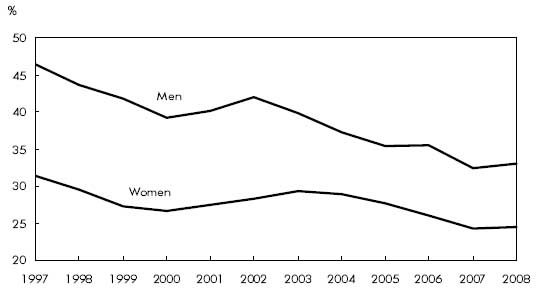Common menu bar links
Involuntary part-time work among adult Canadians
Archived Content
Information identified as archived is provided for reference, research or recordkeeping purposes. It is not subject to the Government of Canada Web Standards and has not been altered or updated since it was archived. Please "contact us" to request a format other than those available.
Involuntary part-time workers aged 25 and over numbered more than half a million (529,000) in 2008, up 4.9% from 2007. This increase contrasts with annual declines averaging 4% from 2004 to 2007.
Involuntary part-time work, a form of underemployment, tends to increase during economic downturns and decrease during recoveries.
People who work part-time involuntarily usually put in less than 30 hours per week at their main job because they can't find full-time employment.
While women account for the majority of involuntary part-time workers, part-time men are more likely to prefer longer hours than women (33.0% versus 24.4% in 2008).
Chart - Involuntary part-time work among Canadians aged 25 years and over

Source: Statistics Canada, Labour Force Survey.
There were almost 2 million part-time workers aged 25 and older in 2008, up 3.8% from the previous year. The number of men working part-time grew at double the pace among women (6.0% versus 3.0%).
Also, from 1997 to 2008, employment among adult men grew at a slower pace, increasing at an annual average of 1.7% versus 2.4% for women. Full-time employment increased 1.6% annually for men compared with 2.8% for women. On the other hand, part-time employment increased 2.8% annually for men versus 1.0% for women.
![]() Table - Involuntary part-time work among Canadians aged 25 years and over
Table - Involuntary part-time work among Canadians aged 25 years and over

